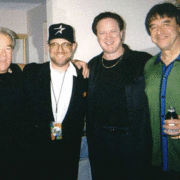PLEASE NOTE: This article has been archived. It first appeared on ProRec.com in April 1998, contributed by then Contributing Editor Pete Leoni. We will not be making any updates to the article. Please visit the home page for our latest content. Thank you!
OK,
We are about back to normal on the beautiful and soggy Mississippi Gulf coast and I have been playing with my D-man 2044 card. After tracking down a small noise problem that I finally cured by reducing my video card’s acceleration, I can now say with confidence that there is a new kid on the block.
The 2044 is a very, very quiet and clean card with a S/N ratio right between the Card-D and the Wave-4. I have access to, and use all of these cards on almost a daily basis so it is relatively easy to make the comparison. Basically what I mean by this statement is that noise is not an issue on any of these cards.
The 2044 as most of you know, is a PCI based 20 bit 4 in/out soundcard. It does not have a MIDI interface nor does it have S/PDIF in or out, the folks at Midiman apparently decided to forego all other features in order to bring in a 20 bit card at a lower price (street price is about $250 ).
At the back of the card is a lone 15 pin connecter that breaks out to 8 good ol’ 1/4″ female inputs. The inputs are all clearly labeled and color coded (4 white / 4 black). The leads to these are pretty thin and tend to braid themselves into a rastafarian/Bob Marley condition in no time at all, so I would strongly advise the addition of a patch bay, or the breakout box that Midiman plans to sell (cheaply, I hear) for the unit.
The installation was instant and painless. Performance is good. I have had no sync problem with Cakewalk. I have also noticed that at lower signal levels the resolution seems to be a little bit better than the 16 bit cards, maybe people have also noticed this with other 20-bit cards.
The DSP chip has reverb and chorus effects on 2 channels only, but they are not that usable at this time, as they are not very adjustable. For now I would not consider them a major feature (Midiman says this will be improved later with future driver releases).
Also in Cakewalk, and only in Cakewalk the audio meters seem to peak out at -2 db, that is to say that if you see -2 on the Cakewalk meters you can consider it to be 0db. In Soundforge, the meters work correctly.
Here is one feature that is not widely known and is really great: the 2044 has selectable -10 or +4 inputs! All you do is remove 4 jumpers and voila +4 ! About time!
Another good feature is the monitor mixer: it runs on the DSP chip and allows you to route any input to any output. This is a pretty handy feature if you don’t have a lot of extra channels in your mixing board to devote to monitoring (with the Card-D, and Wave 4, you must devote channels to monitor use).
Bottom line: this is a great card for the More For Less Club, we have more choices, and it’s great to see good ol’ American competition in the marketplace at work!
Pete Leoni
Demotech Productions

